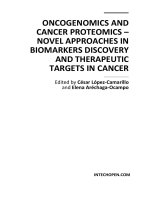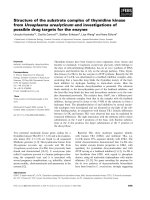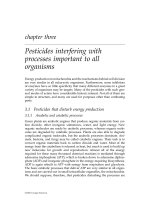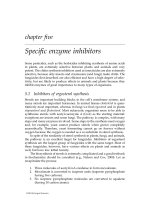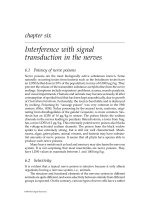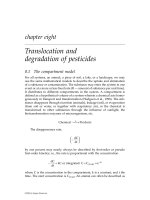QUANTITATIVE CHEMICAL PROTEOMICS INVESTIGATIONS OF TARGETS OF ANDROGRAPHOLIDE AND PROTEOLYSIS OF AUTOPHAGY
Bạn đang xem bản rút gọn của tài liệu. Xem và tải ngay bản đầy đủ của tài liệu tại đây (9.25 MB, 146 trang )
QUANTITATIVE CHEMICAL PROTEOMICS
INVESTIGATIONS OF TARGETS OF
ANDROGRAPHOLIDE AND PROTEOLYSIS OF
AUTOPHAGY
WANG JIGANG
(B.Sc., South China University of Technology)
A THESIS SUBMITTED
FOR THE DEGREE OF DOCTOR OF PHILOSOPHY
DEPARTMENT OF BIOLOGICAL SCIENCES
NATIONAL UNIVERSITY OF SINGAPORE
2013
I
DECLARATION
I hereby declare that this thesis is my original work and it has been written by
me in its entirety. I have duly acknowledged all the sources of information
which have been used in the thesis.
This thesis has also not been submitted for any degree in any university
previously.
Wang Jigang
05 Sep 2013
II
III
Table of Contents
DECLARATION I
Table of Contents III
Summary VII
List of Publications IX
List of Tables XI
List of Figures XIII
List of Schemes XVI
List of Symbols XX
Introduction 1
Chapter 1
1.1 Summary 1
1.2 “Omics” and Proteomics 2
1.3 Gel based Proteomics and Two Dimensional Gel Electrophoresis (2-DE) 5
1.4 LC-MS/MS based proteomics and quantitative proteomics 7
1.4.1 Stable isotope labeling by amino acids in cell culture (SILAC) 8
1.4.2 Isotope-coded affinity tags (ICAT) 10
1.4.3 iTRAQ – Multiplexed chemical tagging for quantitation 11
1.5 Emerging Chemical Proteomics 15
1.5.1 Drug target identification 15
1.5.2 Activity-based protein profiling 18
1.5.3 Tandem bio-orthogonal labeling and Click chemistry for probe design 21
1.5.4 Chemical metabolic labeling with unnatural amino acid 23
IV
1.6 Objectives 25
A Quantitative Chemical Proteomics Approach to Profile the Specific
Chapter 2
Cellular Targets of Andrographolide, a Promising Anticancer Agent that
Suppresses Tumor Metastasis 27
2.1 Summary 27
2.2 Introduction 27
2.3 Results and Discussion 33
2.3.1 Design and synthesis of Andro-based probes 33
2.3.2 In situ proteome profiling 35
2.3.3 ICABPP and target identification 36
2.3.4 Targets validation and functional analysis 42
2.4 Conclusion 50
Development of a novel method for quantification of autophagic
Chapter 3
protein degradation by AHA labeling 51
3.1 Summary 51
3.2 Introduction 52
3.3 Results 54
3.3.1 AHA labeling and detection of AHA by click reaction 54
3.3.2 Optimization of AHA labeling 54
3.3.3 Autophagy-mediated protein degradation detection by AHA fluorescence
59
3.3.4 Autophagy inhibitors reversed the reduction of AHA fluorescence 62
3.3.5 Autophagy deficiency prevented protein degradation measured by AHA
labeling 65
3.4 Discussion 68
3.5 Conclusion and future directions 70
Experimental Procedures 73
Chapter 4
4.1 General 73
V
4.2 Materials and methods of Chapter 2 73
4.3 Materials and methods of Chapter 3 92
Concluding Remarks and future direction 97
Chapter 5
References 103
Chapter 6
Appendix 115
Chapter 7
VI
VII
Summary
The recently advanced quantitative proteomics approaches enabled the
possibility of direct comparison of protein expressions for multiple samples in
a high-throughput manner. Besides measuring the protein abundance changes,
another important topic in proteomics is to provide direct information on
protein activity and protein interaction, including protein-protein and
protein-small molecule interactions. The emerging chemical proteomics offers
a means to systematically analyse the protein activity and small molecule
interaction other than protein abundance alone. In the first part of this thesis,
we described a newly developed quantitative chemical proteomics approach
which allows unbiased and specific drug target profiling. Using this method, a
spectrum of specific targets of Andrographolide (Andro) was identified,
revealing the mechanism of action of the drug and its potential novel
application as a tumor metastasis inhibitor, which was validated through cell
migration and invasion assays. Moreover, the target binding mechanism of
Andro was unveiled with a combination of drug analogue synthesis, protein
engineering and mass spectrometry-based approaches and the drug-binding
sites of two protein targets, NF-B and actin, were determined. In the second
part of this thesis, we present a novel method to determine the autophagic
protein degradation level using chemical metabolic labeling. The sensitivity
and accuracy of this new methodology was validated using different
autophagy induction and inhibition approaches. The two projects, though
independent of each other, have both demonstrated the critical role that
quantitative chemical proteomics plays in today’s biomedical research.
VIII
IX
List of Publications
(2010-2013)
1. Jigang Wang, † Chong-Jing Zhang,† Jianbin Zhang, Songbi Chen, Yingke
He, Han-Ming Shen, Qingsong Lin*. Development of Quantitative
Acid-cleavable Activity-based Protein Profiling (QA-ABPP) and its
application for mapping sites of Aspirin induced acetylations in live cells.
(2013) Nat. Commun., submit soon
2. Jigang Wang, Zhen Li, Caixia Li, Yew Mun Lee, Zhiyuan Gong,*
Qingsong Lin.* (*co-corresponding) Quantitative Proteomics study of
liver cancer using transgenic zebrafish model. (2013), Journal of Proteome
Research, submit soon
3. Jigang Wang, Yew Mun Lee, Caixia Li, Zhen Li, Zhiyuan Gong,*
Qingsong Lin.* (*co-corresponding) Effective Protein Extraction with
Sodium Deoxycholate Promotes Proteomics Study of Whole Zebrafish
Liver with Hepatocellular Carcinoma. (2013), Journal of Proteomics,
submit soon
4. Jianbin Zhang*, Jigang Wang*, Shukie Ng, Qingsong Lin
#
, Han-Ming
Shen
#
(* equal contribution, # co-corresponding). Development of a novel
method for quantification of autophagic protein degradation by AHA
labelling. (2013), Autophagy, accepted and in press.
5. Jigang Wang, Xing Fei Tan, Van Sang Nguyen, Peng Yang, Jing Zhou,
Mingming Gao, Zhengjun Li, Teck Kwang Lim, Yingke He, Chye Sun
Ong, Yifei Lay, Jianbin Zhang, Guili Zhu, Siew-Li Lai, Dipanjana Ghosh,
Yu Keung Mok, Han-Ming, Qingsong Lin.* A Quantitative Chemical
Proteomics Approach to Profile the Specific Cellular Targets of
Andrographolide, a Promising Anticancer Agent that Suppresses Tumor
Metastasis. (2013), Molecular & Cellular Proteomics, mcp.M113.029793.
First Published on January 20, 2014, doi:10.1074/mcp.M113.029793
X
6. Higuchi S, Lin Q, Wang J, Lim TK, Joshi SB, Anand GS, Chung MC,
Sheetz MP, Fujita H. Heart extracellular matrix supports cardiomyocyte
differentiation of mouse embryonic stem cells. J Biosci Bioeng. 2013 Mar;
115(3):320-5.
7. Wu, H.; Ge, J.; Yang, P Y ; Wang, J.; Uttamchandani, M.; Yao, S.Q.
*
A
Peptide Aldehyde Microarray for High-Throughput Detection of Cellular
Events. J. Am. Chem. Soc. (2011), 133, 1946-1954.
8. Kalesh, K.A.; Sim, S. B. D ; Wang, J.; Liu, K.; Lin, Q.; Yao, S.Q.* Small
molecule probes that target Abl kinase. Chem. Commun. (2010), 46,
1118-1120.
9. Kalesh, K.A,; Tan, L.P.; Liu, K.; Gao, L.; Wang, J.; Yao, S.Q.*
Peptide-based Activity-Based Probes (ABPs) for Target-Specific Profiling
of Protein Tyrosine Phosphatases (PTPs). Chem. Commun. (2010), 46,
589-591.
XI
List of Tables
Table 2.1 IC
50
values of Andro in HCT116, MV4-11, HeLa, and HepG2 cell
lines 34
Table 2.2 The potential protein targets related to cell migration and metastasis
identified by ICABPP 39
Table 5.1 Potential celastrol targets identified using ICABPP approach which
have also been reported as celastrol targets in other studies. 99
XII
XIII
List of Figures
Figure 1.1 Comparison of conventional proteomics and chemical proteomics
approaches. 2
Figure 1.2 Two major strategies for protein identification. 4
Figure 1.3 Two Dimensional Electrophoresis (2DE) separation of HCT116 whole
proteome. 6
Figure 1.4 Quantitative proteomics employing the SILAC method. 9
Figure 1.5 Quantitative proteomics by using isotope-coded affinity tag (ICAT). 12
Figure 1.6 Structure of iTRAQ reagent and labeling work flow of iTRAQ. 14
Figure 1.7 Structure of an Activity (Affinity) based probe. 18
Figure 1.8 General workflow of target profiling using activity-based probe (ABP).
19
Figure 1.9 Click chemistry and Staudinger ligation. (A) Copper (I)-catalyzed “click”
chemistry. (B) Staudinger ligation 21
Figure 1.10 General workflow of the targets profiling using “clickable”
cell-permeable probe in live cells. 22
Figure 1.11 AHA labeling of newly synthesized proteins. 24
Figure 2.1 General workflow of the potential cellular target profiling using
cell-permeable, activity-based Andro probe. 29
Figure 2.2 Identifying specific drug targets using ICABPP approach in live cells. 31
Figure 2.3 Chemical structures of Andro, reduced Andro analogue RA and
Andro-based clickable ABPP probe P1 and P2. 32
Figure 2.4 Viability of HCT116 cells after 48 hrs of treatment with Andro(100 µM),
P1(100 µM), P2(100 µM) and RA (100 µM). 35
Figure 2.5 The in situ fluorescent labeling of HCT116 cells using P1 and P2. 36
Figure 2.6 Venn diagram showing the numbers of proteins quantified by ICABBP.
37
Figure 2.7 Heat map of the enrichment ratio of potential Andro targets fulfilled the
statistical requirement. 38
XIV
Figure 2.8 Ingenuity Pathway Analysis (IPA) revealing that Andro affects the cell
migration and metastasis. 39
Figure 2.9 Ingenuity Pathway Analysis (IPA) reveals Andro affecting cancer cell
death and survival. 40
Figure 2.10 Ingenuity Pathway Analysis (IPA) reveals Andro affecting
inflammatory and immunological pathways. 40
Figure 2.11 Western-blot validation of pulled-down fractions of HCT116 by P2. 42
Figure 2.12 In vitro labeling of recombinant NF-κB p50 protein with P2. 43
Figure 2.13 The MS/MS spectra of the NF-κB p50 peptide containing Cys62.
44
Figure 2.14 The schematic of the reaction of Cys with Andro. 45
Figure 2.15 Docking simulation model showing Andro binding to the NF-κB p50.
45
Figure 2.16 In vitro labeling of purified -actin protein using P2. 46
Figure 2.17 The MS/MS spectra of -actin peptide containing Cys272. 47
Figure 2.18 Inhibition of cancer cell migration and invasion by Andro. 48
Figure 2.19 Flow cytometry cell cycle analysis of HCT116 cells treated with Andro
(31 µM). 49
Figure 2.20 Cell cycle analysis of Andro-treated HeLa cells (a) and HepG2 cells (b)
by flow cytometry. 49
Figure 3.1 AHA labeling of newly synthesized proteins. 55
Figure 3.2 Workflow for AHA labeling-based quantitative analysis of protein
degradation. 56
Figure 3.3 Dose- and time-dependent metabolic labeling of AHA in MEFs. 57
Figure 3.4 Visualization of AHA-labeled proteins. 58
Figure 3.5 Morphological changes of MEFs with different dosages of AHA labeling.
59
Figure 3.6 Autophagy induction increased long-lived protein degradation. 60
Figure 3.7 Western confirmations of Starvation and chemical induced Autophagy in
MEFs. 62
Figure 3.8 Autophagy inhibition blocked long-lived protein degradation. 63
Figure 3.9 Western confirmations of Autophagy inhibition by Bafilomycin and
Wortmannin in MEFs. 64
Figure 3.10 Western confirmations of Autophagy inhibition by Bafilomycin and
XV
Wortmannin in HepG2. 65
Figure 3.11 Defective autophagy impaired long-lived protein degradation. Atg5 WT
and KO MEFs (A) and Atg7 WT and KO MEFs. 66
Figure 3.12 Western confirmations of Autophagy inhibition and deficiency in Atg
WT and KO MEFs. Atg5 WT and KO MEFs. 67
Figure 5.1 Drugs that have also been successfully developed into activity based
probes and used in ICABPP for target identification in our lab. 98
Figure 5.2 The in situ fluorescent labeling of HCT116 cells using Celastrol probe. 98
Figure 5.3 The in situ fluorescent labeling of newly synthesized proteins of Hela
cells under normal and starvation conditions. 100
Figure 5.4 IPA pathways analysis of the newly synthesized proteins during
autophagy inductions. 101
XVI
List of Schemes
Scheme 2.1 The synthetic scheme for RA. 32
Scheme 2.2 The synthetic scheme for P1. 32
Scheme 2.3 The synthetic scheme for P2. 33
Scheme 4.1 The synthetic scheme for RA. 74
Scheme 4.2 The synthetic scheme for P1. 75
Scheme 4.3 The synthetic scheme for P2. 78
XVII
List of Abbreviations
2-DE Two- dimensional electrophoresis
AA Amino acid
ABP Activity Based Probe
Andro andrographolide
AHA Azidohomoalanine
BSA Bovine serum albumin
CaCl
2
Calcium chloride
δ Chemical shift in ppm
C.I Confidence interval
CID Collision-induced dissociation
Cu Copper
Da Dalton
CUAAC Copper (I) catalyzed Azide-alkyne cycloaddition
Cy Cyanine
DIGE Difference in gel electrophoresis
DMSO Dimethyl sulfoxide
DTT Dithiothreitol
E. coli Escherichia coli
EDTA Ethylenediamine tetraacetic acid
ESI Electrospray ionization
FACS Fluorescence activated cell sorting
FITC Fluorescein isothiocyanate
HEPES 4-(2-hydroxyethyl)-1-piperazineethanesulfonic acid
HGP Human Genome Project
HPLC High performance liquid chromatography
IC50 Half the maximal inhibitory concentration
IPG Immobilized pH gradients
IEF Isoelectric focusing
XVIII
GO Gene ontology
h Hour
ICAT Isotope-Coded Affinity Tags
IPI International Protein Index
iTRAQ Isobaric Tag for Relative and Absolute Quantitation
min Minute
LC Liquid chromatography
MALDI Matrix-assisted laser desorption ionization
MMTS Methylmethanethiosulphate
MudPIT Multidimensional protein identification technology
MS Mass spectrometry
mTOR Mammalian Target Of Rapamycin
MOA Mechanism of Action
NaHCO3 Sodium bicarbonate
NMR Nuclear magnetic resonance
P.I Propidium iodide
PAGE PAGE polyacrylamide gel electrophoresis
PBS Phosphate buffered saline
PBS-T Phosphate buffered saline- Tween
PI Isoelectric point
PTM Post-translational modification
PVDF Polyvinylidene fluoride
RP Reverse-phase
ROS Reactive oxygen species
rpm Rotations per minute
r.t. Room temperature
s Second
SAR Structure-activity relationship
S/N Signal to noise ratio
SDS Sodium dodecyl sulphate
XIX
SDS-PAGE Sodium dodecyl sulphate- polyacrylamide gel electrophoresis
TBTA Tris[(1-benzyl-1H-1,2,3-triazol-4-yl)methyl]amine
TCEP Tris(2-carboxyethyl)
TEAB Triethylammonium bicarbonate Buffer
TMR tetramethylrhodamine
Tris Trishydroxymethyl amino methane
μ Micron
μg Microgram
μl Microlitre
XX
List of Symbols
Å angstrom
Ԩ
degree celsius
g gram
h hour
k kilo
l litre
w wavelength
m milli or meter
μ micro
M molar
min min
mol mole
n nano
p pico
s second
XXI
List of Twenty Natural Amino Acids
Single Letter Code Three Letter Code Full Name
A Ala Alanine
C Cys Cysteine
D Asp Aspartate
E Glu Glutamate
F Phe Phenylalanine
G Gly Glycine
H His Histidine
I Ile Isoleucine
K Lys Lysine
L Leu Leucine
M Met Methionine
N Asn Asparagine
P Pro Proline
Q Gln Glutamine
R Arg Arginine
S Ser Serine
T Thr Threonine
V Val Valine
W Trp Tryptophan
Y Tyr Tyrosine
XXII
1
Chapter 1
Introduction
1.1 Summary
Proteins are basic structural scaffolds, playing various important roles in
living organisms. The large scale “omics” study, especially proteomics, is
continuing to provide important insights into various biological processes.
With the increasing sensitivity of modern mass spectrometry platform,
thousands of proteins and numerous posttranslational modifications can be
examined simultaneously in any biological system. The recently advanced
quantitative proteomics approaches enabled the possibility of direct
comparison of protein expressions for multiple samples in a high-throughput
manner. These methods already play important roles in biomarker discovery,
drug treatment perturbation and disease mechanism studies. Besides
measuring the protein abundance changes, another important area in
proteomics is to provide direct information on protein activity and protein
interaction, including protein-protein and protein-small molecule interactions.
The emerging chemical proteomics offers a means to systematically analyse
the protein activity and small molecule interaction other than protein
abundance alone. This chapter will give a brief overview of the currently
available quantitative proteomics methods as well as the emerging chemical
proteomics technology. Much attention will be focused on stable isotope-based
quantitative proteomics, drug target identification and metabolic labeling of
proteome with unnatural amino acids.
